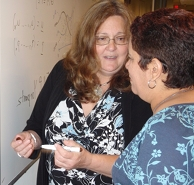 NIMBioS News NIMBioS News
Bi-Monthly News from the National Institute for Mathematical and Biological Synthesis September-October 2011 - Vol 3, Issue 5
|
|
|
| Report Your Results |
The results produced from NIMBioS research activities are important in measuring our success. Click the button below
for an online form to report publications and/or other products that have resulted from your NIMBioS activities.
Click here
for specific language to use in acknowledging NIMBioS in your work.
|
|
|
New Faces at NIMBioS
|
 | |
New postdoctoral fellows are, from left, Andrew Kanarek, Calistus Ngonghala, J.J. Chai, Dan Ryan and Orou Gaoue.
|
NIMBioS welcomes five new postdoctoral fellows whose research focuses on a variety of topics, including non-timber forest products harvest, the dynamics of malaria transmission, individual trait variation in small communities, movement strategies in multi-trophic ecological communities, and maximum parsimony in phylogenetics. Our new sabbatical visitor is Gary Stuart (Biology, Indiana Univ.) who is developing new non-alignment phylogenomic methods for determining relationships at the species, subspecies and population levels. December 11 is the next deadline for submitting requests for postdoctoral support, and March 1 is the deadline for sabbatical requests. All areas of research at the interface of biology and mathematics will be considered, but we are especially interested in activities expanding beyond the areas of research supported to date, including research in areas of molecular biology, cell biology, network biology, immunology and systems biology. Postdoctoral fellowships are supported for two years. The online application for postdoctoral support and tips for applicants are available on our website. This flyer announces the call for applications for postdoctoral fellowships.
|
|
|
|
Featured Science: The Legume-Rhizobium Symbiosis?
| 
The symbiosis between legume plants and the bacteria that inhabit their roots seems sweet. These bacteria, called rhizobia, turn nitrogen molecules from the air into a form that the plant can use and, in return, feast on carbohydrates the plant provides. But conflicting interests lurk beneath the surface and can undermine such cooperation, as both parties might prefer to benefit without paying their dues. A new study shows that the process determining the exchange rate of nitrogen and carbohydrates has profound effects on how cooperation can be maintained between legumes and rhizobia. |
Video Spotlight: Biology in a Box, the Movie!
|  Biology in a Box is a fun, hands-on way for students from kindergarten to 12th grade to learn about the wonders of the natural world, while also learning the scientific methods and math skills needed to understand that world. NIMBioS has added quantitative exercises into the ten hands-on, inquiry-based life science units, with more under development. In this video, 7th grade science students talk about what they're learning as they dig into the boxes. The video also features interviews with their teacher and with the creator of Biology in a Box. For more information about the program, click here. Biology in a Box is a fun, hands-on way for students from kindergarten to 12th grade to learn about the wonders of the natural world, while also learning the scientific methods and math skills needed to understand that world. NIMBioS has added quantitative exercises into the ten hands-on, inquiry-based life science units, with more under development. In this video, 7th grade science students talk about what they're learning as they dig into the boxes. The video also features interviews with their teacher and with the creator of Biology in a Box. For more information about the program, click here. |
Upcoming Research and Training Opportunities at NIMBioS
|  INVESTIGATIVE WORKSHOP: MODELING CLIMATE-CARBON INVESTIGATIVE WORKSHOP: MODELING CLIMATE-CARBON
Disturbances have been recognized as a key factor affecting terrestrial biogeochemical processes but can be easily misinterpreted without considering the context of disturbance regimes. NIMBioS is now accepting applications for the NIMBioS Investigative Workshop: Modeling Disturbance Regimes and Climate-Carbon Feedback, to be held Feb. 13-15, 2012, at NIMBioS. Application deadline: Nov. 1, 2011. For more information about the workshop and how to apply, click here.
|
 INVESTIGATIVE WORKSHOP: MODELING DENGUE FEVER INVESTIGATIVE WORKSHOP: MODELING DENGUE FEVER
More than one-third of the world's population lives in areas at risk for the transmission of dengue, a vector-transmitted disease, that is one of the leading causes of death and illness in the tropics and subtropics. This workshop, to be held July 23,-24, 2012, will bring together public health officials as well as mathematicians, biologists and epidemiologists to identify important modeling issues and to establish possible new collaborations on modeling dengue disease dynamics and control. Watch the NIMBioS website for further details.
|
 TEACHER COLLABORATION PROGRAM TEACHER COLLABORATION PROGRAM
NIMBioS is now accepting applications from math and biology/science teachers for the Teacher Collaboration Program, which provides links between teachers, scientists and educators with an interest in making connections between mathematics and biology. To enhance the cross-disciplinary approach to mathematics and biology, NIMBioS will pair teachers with an interest in mathematics and biology with active researchers in the math biology community. For more information and how to apply, click here.
|
| Upcoming Deadlines |
---------------------------------------------------------------------------------------------------------------------------------------------------
|
|
The National Institute for Mathematical and Biological Synthesis (NIMBioS) brings together researchers from around the world to collaborate across disciplinary boundaries to investigate solutions to basic and applied problems in the life sciences. NIMBioS is funded by the National Science Foundation in collaboration with the U.S. Department of Homeland Security and the U.S. Department of Agriculture, with additional support from The University of Tennessee, Knoxville.
____________________________________________________
NIMBioS is located at the Univ. of Tennessee, Knoxville
1534 White Avenue, Suite 400, Knoxville, TN 37996-1527
|
|
|
|
|